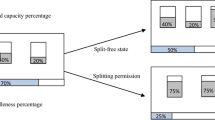Abstract
Transition from a functional system to a cellular system involves partitioning the machine and part populations. Partitioning the machine population degrades the queue time performance. This paper investigates whether splitting the part population into part families can offset the effect of partitioning the machine population on queue time. Queue times are obtained for both cellular and functional systems through queueing theory for single stage production and by simulation for multistage production under identical factor settings of process time, setup time, batch size and part arrival. Unlike past research, this study identifies certain situations where a cellular system without getting benefits in factor settings outperforms a functional system.
Similar content being viewed by others
References
Wemmerlov U, Johnson DJ (2000) Empirical findings on manufacturing cell design. Int J Prod Res 38(3):481–507
Johnson DJ, Wemmerlov U (1996) On the relative performance of functional and cellular layouts: an analysis of the model based comparative studies literature. Prod Oper Manag 5(4):309–334
Agarwal A, Sarkis J (1998) A review and analysis of comparative performance studies on functional and cellular manufacturing layouts. Comput Ind Eng 34:77–89
Flynn BB, Jacobs FR (1987) An experimental comparison of cellular (group technology) layout with process layout. Decision Sci 18:562–581
Morris JS, Tersine RJ (1990) A simulation analysis of factors influencing the attractiveness of group technology cellular layouts. Manage Sci 36(12):1567–1578
Suresh NC (1991) Partitioning work centers for group technology: insights from an analytical model. Decision Sci 22(4):772–791
Suresh NC (1992) Partitioning work centers for group technology: analytical extension and shop-level simulation investigation. Decision Sci 23(2):267–290
Wemmerlov U, Hyer NL (2002) Re-organizing the factory competing through cellular manufacturing. Productivity Press, USA
Suresh NC, Meredith JR (1994) Coping with the loss of pooling synergy in cellular manufacturing systems. Manage Sci 40(4):466–483
Shafer SM, Charnes JM (1993) Cellular versus functional layouts under a variety of shop operating conditions. Decision Sci 24(3):665–681
Hopp WJ, Spearman ML (1996) Factory physics: foundations of manufacturing management. Irwin/McGraw Hill, USA
Kelton WD, Sandowski RP, Sandowski DA (1998) Simulation with arena. McGraw Hill, USA
Author information
Authors and Affiliations
Corresponding author
Rights and permissions
About this article
Cite this article
Pitchuka, L.N., Adil, G.K. & Ananthakumar, U. Effect of conversion of functional layout to a cellular layout on the queue time performance: some new insights. Int J Adv Manuf Technol 31, 594–601 (2006). https://doi.org/10.1007/s00170-005-0219-2
Received:
Accepted:
Published:
Issue Date:
DOI: https://doi.org/10.1007/s00170-005-0219-2




